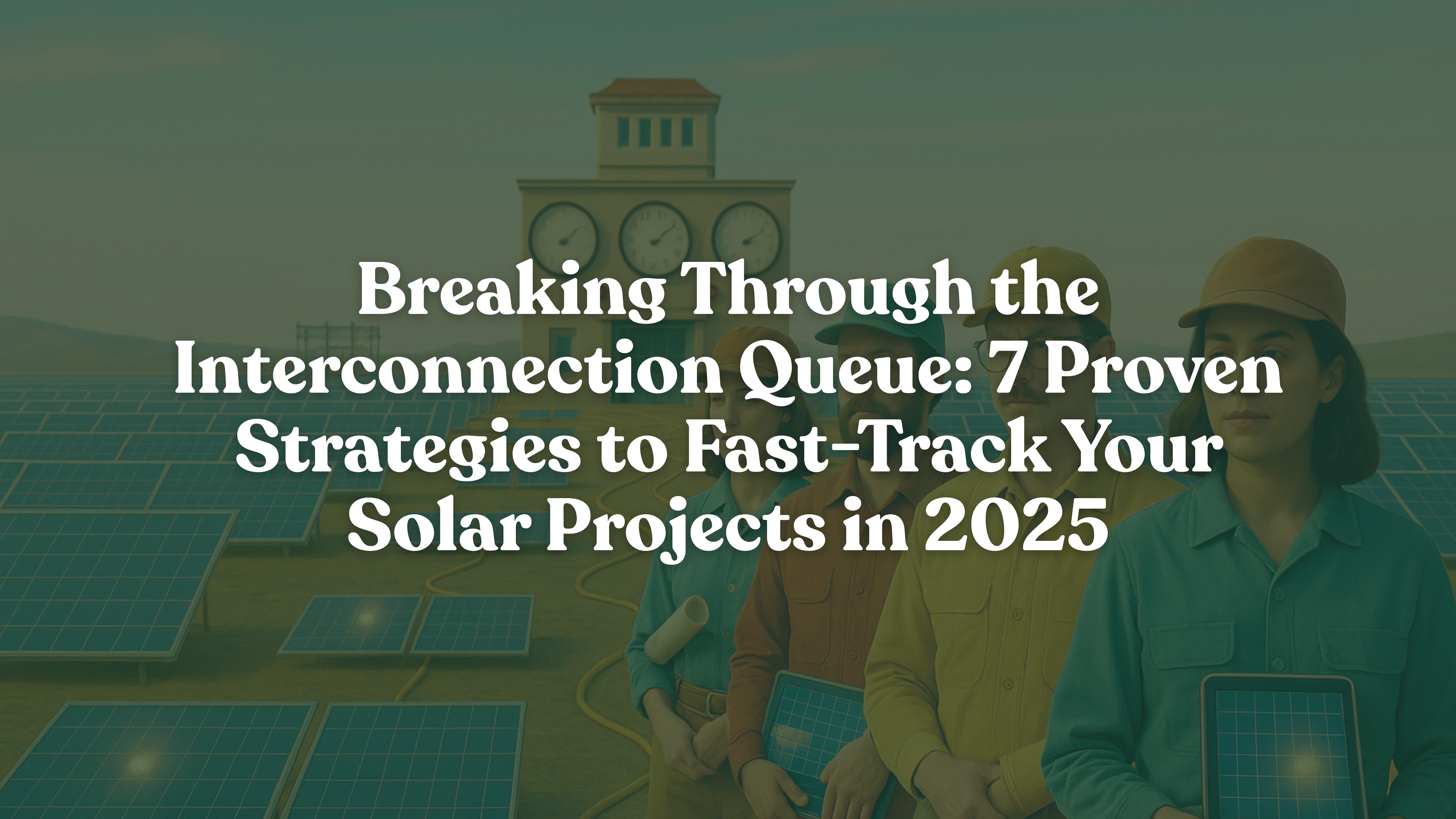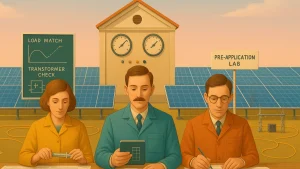Interconnection Queue Solar Projects: 7 Strategies

Interconnection Queue Solar Projects: 7 Proven Strategies to Fast-Track Grid Connection Approvals in 2025
Quick Answer: How to Accelerate Interconnection Queue Solar Projects
The interconnection queue backlog has grown 30% since 2023, with solar projects representing over 1,080 GW stuck in line. However, successful solar installers and EPCs are cutting approval times by 40% using seven strategic approaches: mastering pre-application due diligence, perfecting documentation, leveraging FERC Order 2023 reforms, considering hybrid projects, building utility relationships, managing portfolio risk, and deploying automation technology.
The interconnection queue solar projects challenge has become the industry’s biggest bottleneck. Currently, over 2.6 terawatts of generation capacity are waiting for grid connection—more than double the entire U.S. power fleet. For solar installers and EPCs, these delays can stretch projects from months into years.

Moreover, only 14% of interconnection queue solar projects historically complete the process successfully, according to Lawrence Berkeley National Laboratory research. The remaining projects? They withdraw after burning through time, capital, and client relationships.
However, it doesn’t have to be this way. While the queue crisis affects everyone, strategic solar EPCs consistently achieve faster approvals and completed projects.
DEFINITION BOX: What is the Interconnection Queue?
The interconnection queue is the formal line of generation projects waiting for utility approval to connect to the electrical grid. Before any solar project can operate, it must undergo technical studies to determine grid impacts and required upgrades. This process—managed by utilities, ISOs, and RTOs—has become severely congested due to the renewable energy surge.
Why Did Interconnection Queue Solar Projects Become a Crisis?
The statistics tell a concerning story. According to the Lawrence Berkeley National Laboratory’s “Queued Up” report, the average project now spends five years in the interconnection queue. That’s up from just two years in 2008.
Furthermore, interconnection queue solar projects alone represent over 1,080 GW of capacity awaiting approval. That’s enough to power millions of homes—if these projects could just get connected.
Three Root Causes Drive the Backlog
Infrastructure limitations: Our transmission grid wasn’t designed for today’s renewable energy boom. Between 2022 and 2023, the queue backlog surged by 30%. Utilities are struggling to process applications fast enough.
Application quality problems: Grid operators report that over 90% of interconnection applications contain errors requiring revision. These deficiencies trigger restudies, which delay other projects and clog the entire system.
Regulatory implementation gaps: While FERC Order 2023 introduced landmark reforms, implementation varies widely across grid operators. This inconsistency creates confusion and additional delays for developers.
KEY STATISTIC
78% of energy projects submitted between 2000-2018 withdrew from interconnection queues without completing construction, according to research published in the Journal Joule.
Strategy 1: How to Master Pre-Application Due Diligence for Solar Projects
The biggest interconnection mistakes happen before submission. Consequently, successful EPCs invest heavily in upfront analysis.
Essential Pre-Application Assessments
Site load reconciliation: First, reconcile your proposed solar output with actual site loads. Utilities immediately flag mismatches, sending applications back for revision. This single error can add months to your timeline.
Transformer capacity evaluation: Next, assess whether existing transformers can handle solar backfeed. Older sites often require upgrades. Identify these needs during design—not after utility review.

Grid impact analysis: Additionally, evaluate your system’s potential impact on local distribution. Understanding feeder capacity and transformer proximity helps you anticipate detailed review triggers. Use interconnection queue mapping tools to assess site viability.
Fast-track eligibility check: Finally, determine whether your project qualifies for expedited review. Not every project meets fast-track criteria, but many eligible projects still enter standard queues due to poor planning.
Strategy 2: How to Perfect Your Interconnection Application Package
Application deficiencies cause the majority of interconnection queue solar projects delays. Therefore, getting documentation right the first time is critical.
Documentation Excellence Checklist
Standardize your templates: Create reusable templates for one-line diagrams, protection schemes, and technical specifications. Version control ensures consistency across your engineering team.
File naming precision matters: If filenames don’t match required conventions (example: “ProjectName_OneLine_Rev1.pdf”), some utilities automatically reject applications. Additionally, portal systems scrape metadata fields. Blank or mismatched data triggers immediate delays.
Complete modeling requirements: Non-synchronous generating facilities like solar must provide accurate models for interconnection studies. Missing or incorrect models require restudies that add months to timelines.
Metadata validation: Before submission, validate all metadata fields. Many systems reject reviews based on invalid data like system size, AC ratings, or customer IDs.
Protection scheme accuracy: Ensure protective equipment specifications match utility standards. Different utilities require different configurations. A proactive call to clarify requirements prevents weeks of delays.
Strategy 3: How to Leverage FERC Order 2023 Reforms for Faster Approvals
FERC Order 2023 represents the most significant interconnection reform in two decades. Smart solar EPCs are adapting quickly to gain competitive advantage.
Key FERC Order 2023 Changes
Cluster study approach: Instead of first-come, first-served processing, utilities now evaluate projects in groups. This means timing submissions strategically during annual 60-day customer engagement windows.
Enhanced information transparency: Utilities must publicly post interconnection data. Use this information to assess site viability and upgrade costs before committing resources. This transparency reduces speculative applications.
Accelerated study timelines: Transmission providers face 150-day deadlines for cluster studies. Financial penalties apply for delays. Know these deadlines and hold utilities accountable to keep your projects moving.

Proportional cost allocation: Network upgrade costs are now allocated more equitably using technical analyses. This prevents single projects from bearing disproportionate upgrade burdens.
First-ready, first-served processing: Projects demonstrating readiness move forward faster. This rewards thorough preparation and complete applications.
IMPACT DATA
According to grid interconnection analysis, FERC Order 2023 reforms could reduce average queue times by 20-30% once fully implemented across all transmission providers.
Strategy 4: Why Solar-Plus-Storage Projects Get Faster Approvals
Currently, 571 GW of hybrid capacity sits in interconnection queue solar projects. These solar-plus-storage combinations offer strategic advantages for developers.
Hybrid Project Benefits
Enhanced capacity factors: Storage helps utilities manage grid stability concerns. This can smooth your path through technical review processes.
Shared upgrade allocation: Under FERC Order 2023’s proportional impact method, network upgrade costs distribute more fairly among clustered projects.
Premium market value: Hybrid projects command higher power purchase agreement rates. This justifies interconnection investments and upgrade costs.
Grid services revenue: Storage enables participation in ancillary services markets. These additional revenue streams improve project economics.
Reduced curtailment risk: Storage captures excess generation that might otherwise be curtailed during high-production periods.
Strategy 5: How to Build Utility Relationships That Accelerate Approvals
The most successful EPCs don’t just submit applications—they communicate proactively.
Relationship-Building Tactics
Establish direct contacts: Build relationships with utility interconnection staff before you need them. Personal connections speed problem resolution.
Proactive clarification calls: A single phone call clarifying a diagram or specification prevents weeks of delays. Don’t wait for rejection notices.
Demonstrate technical expertise: When discussing protection schemes or transformer configurations, showcase your knowledge. Technical credibility builds trust and speeds approvals.

Regular status monitoring: Don’t wait passively. Schedule regular check-ins to keep your interconnection queue solar projects visible and surface issues early.
Attend utility workshops: Many utilities host interconnection workshops. These sessions provide valuable insights into their priorities and processes.
Document everything: Keep detailed records of all communications. This documentation proves invaluable when disputes arise or timelines slip.
Strategy 6: Portfolio Risk Management for Interconnection Uncertainty
With interconnection success rates below 15%, diversification becomes essential for business survival.
Risk Mitigation Approaches
Geographic diversification: Spread projects across multiple utility territories. Different grid operators have varying backlogs and processing speeds. This reduces concentration risk.
Multiple strategic positions: While speculative applications contributed to today’s crisis, maintaining strategic backup positions protects against individual project failures.
Contingent financing structures: Tie financing milestones to interconnection approval rather than fixed dates. This approach protects both EPCs and investors from queue delays.
Hedging strategies: Protect against commodity price exposure during extended development periods. Material costs can shift significantly during multi-year queues.
Insurance evaluation: Some specialized insurers now offer interconnection delay coverage. Evaluate these products for large-scale projects.
Data-driven decision making: Track your historical success rates by utility, region, and project size. Use this data to inform future site selection.
Strategy 7: Deploy Technology to Automate Interconnection Processes
Leading solar EPCs use technology to gain measurable competitive advantage.
Technology Solutions
Digital site assessment platforms: Modern survey applications streamline grid assessments and documentation from project inception. These tools reduce site visit time by 50%.
Solar-specific CRM systems: Project management platforms help track interconnection milestones, deadlines, and documentation requirements across multiple projects simultaneously.
Automated compliance checking: Before submission, software tools verify applications meet all utility-specific requirements and formatting standards. This eliminates manual review errors.
Document management systems: Version-controlled repositories ensure your team always uses current templates and specifications.
Deadline tracking automation: Automated reminders prevent missed submission windows and response deadlines that could derail projects.
Workflow standardization: Digital tools enforce consistent processes across your organization, reducing variability in application quality.
What Interconnection Queue Delays Cost Your Business
Interconnection delays aren’t merely inconveniences—they’re profit killers with real financial impact.
The True Cost of Delays
Increased carrying costs: Extended timelines mean longer periods paying for land options, insurance, and development overhead.
Lost Power Purchase Agreements: Many PPAs have time-limited execution windows. Miss the window, lose the contract.
Damaged client relationships: Residential and commercial customers lose trust when promised timelines slip repeatedly.
Opportunity costs: Capital tied up in delayed projects can’t fund new opportunities. Your business growth stalls.
Competitive disadvantage: Meanwhile, EPCs who master these strategies consistently deliver projects 30-40% faster than industry averages.
Market Reality
In today’s competitive solar market, when two installers bid the same project, the one who can promise—and deliver—faster grid connection wins the contract. Speed has become a crucial differentiator.
Looking Ahead: The Interconnection Landscape in 2026 and Beyond
The interconnection queue solar projects crisis won’t resolve overnight. Despite reforms, Lawrence Berkeley National Laboratory estimates that clearing the backlog at current completion rates could take decades.
Industry Outlook
Continued reform implementation: FERC Order 2023 compliance continues rolling out across transmission providers throughout 2025. Expect ongoing process adjustments.
Grid enhancement technologies: Solutions like dynamic line rating systems and advanced conductors could effectively double transmission capacity without new construction, according to The Brattle Group research.
Increased regional variations: Different ISOs and RTOs are implementing reforms at different paces. Geographic strategy becomes increasingly important.
Technology acceleration: AI-powered application review and automated grid impact assessment could streamline processes within 3-5 years.
The Competitive Opportunity
However, this challenge creates opportunity. As less-prepared competitors struggle with delays and withdrawals, EPCs with systematic interconnection strategies capture increasing market share.
The solar installers who thrive in 2025 and beyond will be those who treat interconnection not as paperwork, but as a strategic competitive advantage.
Ready to Accelerate Your Solar Project Approvals?
Sunscape delivers solar project management software purpose-built for installers and EPCs who refuse to wait. Our comprehensive Solar CRM and site survey tools streamline everything from initial grid assessments to interconnection documentation submission. Track every project milestone, standardize application packages, and coordinate teams effortlessly—all in one integrated platform. When speed equals profitability, Sunscape keeps you moving forward. Explore Sunscape Solutions →
Energyscape Renewables provides the engineering expertise that gets interconnection queue solar projects approved on the first submission. As your nationwide solar engineering partner, we deliver utility-ready plan sets, code-compliant designs, and complete interconnection support for residential, commercial, and utility-scale projects. Our PE-stamped drawings and accurate electrical documentation pass utility review without the costly rework causing delays. From initial design through final interconnection, we engineer for approvals—not revisions. Partner with Energyscape Renewables →
Frequently Asked Questions About Interconnection Queue Solar Projects
How long does the solar interconnection queue take in 2025?
The average interconnection queue solar project now spends five years from application to approval, according to Lawrence Berkeley National Laboratory. However, timelines vary significantly by region. Some fast-tracked projects receive approval in under one year, while complex utility-scale projects can wait 6-8 years in congested markets.
What percentage of solar projects successfully complete interconnection?
Only 14% of solar projects historically complete the interconnection process. The remaining 86% withdraw due to costs, delays, or changed economics. However, EPCs implementing systematic strategies achieve completion rates above 30%.
How does FERC Order 2023 affect my solar projects?
FERC Order 2023 introduces cluster-based processing, enhanced transparency, and faster study timelines. Projects are now evaluated in groups during annual windows, and utilities face penalties for delays. These reforms should reduce average queue times by 20-30% once fully implemented.
Should I consider solar-plus-storage instead of standalone solar?
Solar-plus-storage projects currently represent 571 GW in interconnection queues and often receive preferential treatment during utility reviews. Storage helps address grid stability concerns and enables additional revenue streams. For projects over 1 MW, hybrid configurations increasingly make strategic sense.
What’s the biggest mistake solar EPCs make with interconnection applications?
Application deficiencies cause over 90% of delays. The most common mistakes include mismatched file naming, incomplete modeling data, inaccurate protection schemes, and failure to validate metadata fields before submission. These errors trigger restudies that add months to timelines.
How can I track my project’s position in the interconnection queue?
Most utilities and ISOs maintain public interconnection queue dashboards. Additionally, solar-specific project management software can track your position and alert you to status changes. Regular communication with utility interconnection staff provides the most reliable updates.
What are Grid Enhancement Technologies and how do they help?
Grid Enhancement Technologies (GETs) increase transmission capacity without building new lines. Solutions include power flow control devices, dynamic line rating systems, and advanced conductors. Research suggests these technologies could double grid capacity in some regions, potentially reducing queue congestion.

sjayakanth@energyscaperenewables.com